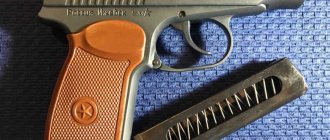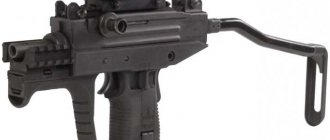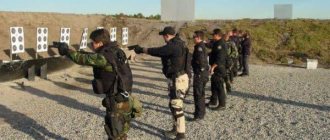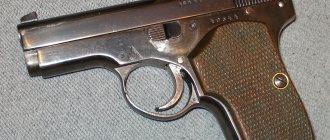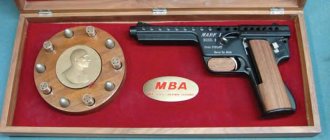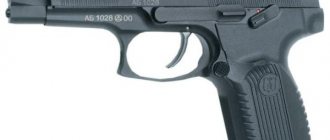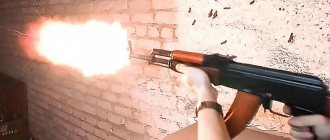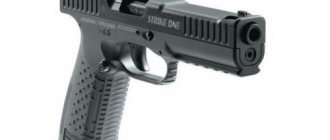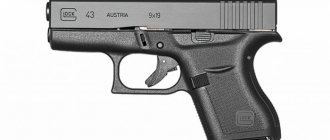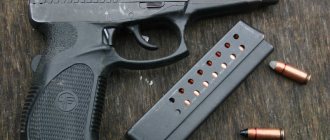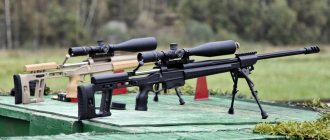Clutch-less systems
Scheme 1. Use of recoil with a free bolt and a stationary barrel.
The bolt is held in its forward position by a spring. When fired, the recoil energy throws it back unhindered. Possessing much more mass than the bullet, the bolt moves much slower than it. Therefore, long before the cartridge case leaves the chamber, the bullet has time to leave the barrel and the pressure in the barrel decreases very sharply. The shutter returns to its original position under the action of the return spring.
Scheme 2. Use of the energy of powder gases with a forward moving barrel and a stationary bolt.
The recoil affects the stationary body and is not used in any way. Reloading is carried out when the barrel moves forward under the influence of the friction force that occurs when the bullet passes through the barrel, and backward under the influence of the return spring.
Firearms automation systems, part 1
I don’t remember in the comments to which article and by whom, but it was proposed to make several materials that would describe the basic principles of the operation of firearms, as well as individual nuances of a particular system. This was proposed in the context of popularizing weapons, since for many, the automatic system with a long barrel stroke and the blowback bolt are just a bunch of words and nothing more. Well, we don’t even need to mention the fact that people pull the trigger and so on. Let's start right away with the complex ones, namely with automation systems, since, having understood them, people will at least have an understanding of how this or that model works.
Usually in weapon reviews I try to at least briefly describe how automation works, but sometimes there are several articles in a row about weapons with the same automation system, as a result, writing the same thing is not at all interesting, and I don’t always want to describe in detail what and how and where it is moving. In this material I would like to cover at least what has been and is being used in firearms at the moment, naturally with specific examples.
The material will be large, sometimes tedious, I will try to write without using terms, that is, roughly speaking, I will explain it on my fingers. So anyone in the subject can safely skip the article, since you won’t learn anything new from it, but anyone who wants to understand how and what works should definitely read it.
Automatic blowback system
Let's start with the simplest thing, namely the blowback automatic system. The closest example to our compatriots would be the Makarov pistol; in addition, the blowback bolt is often used in submachine guns and in those models that use low-power ammunition.
In pistols, blowback is used mainly with cartridges with low kinetic energy of the bullet; the limit for such a system can be called 9x19 ammunition, for which there are several models of pistols with automatic blowback. But such weapons literally operate at the limit of their capabilities, which is why their service life is very short, and the requirements for the quality of materials are very high, which naturally affects the cost. If we talk about submachine guns, then in them the automatic blowback system is used more widely and with a wide variety of ammunition. But first things first.
Automation system with blowback for pistols
We will disassemble the automatic system with a blowback for pistols using the example of the same Makarov pistol (PM), since for people interested in weapons there will always be an opportunity to get acquainted with this pistol due to its wide distribution, at least in the “traumatic” version, which is no different automation system from the original.
Inside the weapon casing, the very part that is pulled so that the cartridge from the magazine moves into the chamber, the uppermost movable part of the pistol, there is a bolt, therefore for most pistols the description says not just a bolt, but a casing-bolt, since these are two parts tightly connected to each other. There are variants of pistols where the bolt is represented as a separate independent part, but there are not many of them.
Despite the fact that the automatic system is blowback, the bolt is actually not that free, its movement is prevented by the weapon's return spring, which in the Makarov pistol is wrapped around the barrel. The return spring rests against the front part of the bolt casing, so in order for the bolt casing, and therefore the bolt itself, to be in its rearmost position, it is necessary to compress the return spring. Well, now how does it all work.
As you know, a bullet moves along the bore due to the fact that gunpowder, during its combustion, releases combustion products in a volume significantly exceeding the volume of the gunpowder itself. Due to this phenomenon, the pressure between the case and the bullet increases very quickly, and therefore more volume is required to reduce this pressure. The increase in the volume free for powder gases occurs precisely due to the fact that the bullet moves along the barrel and the distance between the cartridge case and the bullet increases.
To make it more clear, you can imagine all this in the form of a piston, but with one caveat. Powder gases, expanding, put pressure not only on the bullet itself, but also on the walls of the barrel bore, as well as on the bottom of the cartridge case. If the cartridge case were not supported by the bolt, it would fly out of the chamber in the same way as the bullet, but since the weight of the bolt, casing and cartridge case is greater than the weight of the bullet, and plus the entire casing-bolt does not allow the return spring to move freely, the cartridge case remains in the chamber.
It would be quite timely to ask how recharging occurs in this case. I’ll try to explain it back using a simpler example. If you take two metal balls with a large difference in mass and put a compressed coiled spring between them, then when the spring straightens and pushes the balls, they will move at different speeds, and if the difference in weight is very large, then one of the balls may even remain on place.
In our case, to ensure trouble-free and correct operation of the weapon automation system, it is necessary to ensure that the bolt casing moves after the bullet leaves the barrel, that is, so that it is not the powder gases that push the cartridge case with the bolt, but the heavy bolt casing due to of its mass, retaining the energy received through the cartridge case from the powder gases, pulled the cartridge case out of the chamber. I feel like I’ve piled up a forest - “imagine this, imagine that” - so the lite version of the description of the operation of the automatic blowback system:
When fired, the powder gases expand, push the bullet at high speed along the barrel, pressing on the cartridge case, which transfers the energy received from the powder gases to the bolt casing. Due to the greater mass of the bolt casing, in comparison with the bullet, its speed is much lower than the speed of the bullet, but due to the greater mass, the bolt casing picks up speed more slowly, which is why it is often said that the bolt casing begins to move after the bullet has left trunk, which is not entirely true.
Thus, the automation system can be represented as a system with two movable pistons in one cylinder, differing in the force required for their movement. Well, speaking roughly and not taking into account the fact that one of the pistons continues to move even when the second one has jumped out of the cylinder and the pressure in it has returned to normal.
Well, to make it completely clear, let’s try to go through the points of what happens when a shot is fired using the example of a Makarov pistol :
Semi-blowback systems.
Scheme 3.
Systems with semi-free shutters occupy an intermediate place between systems with free and linked shutters. There is no rigid locking of the barrel here, and slowing down the opening of the bolt during a shot is achieved with the help of devices that increase friction or cause accelerated withdrawal of other parts. The diagram shows the operating principle of the shutter accelerator used in weapons. The shutter, moving under the influence of recoil force, carries two rollers with it. The backward movement of the rollers is accompanied by their approach, which accelerates the withdrawal of the firing pin, and slows the retreat of the bolt.
Scheme 4 . Using recoil with a long barrel stroke.
The bolt and barrel are firmly interlocked during a shot, so recoil pushes them back the entire length of the recoil. After the moving parts reach the rearmost position, the bolt and barrel are disengaged. After that, they are sequentially returned forward. When the barrel moves forward, the cartridge case is extracted, and when the bolt moves, the next cartridge is chambered and the locking device is turned on.
Scheme 5. Using recoil with a short barrel stroke.
The barrel and bolt are rigidly linked to each other using a locking device. When fired, they move back under the strong influence of recoil. Since together they have a large mass, their withdrawal occurs relatively slowly. After the moving parts begin to withdraw, the locking device, interacting with the stationary body, turns off and releases the bolt. The barrel stops after a short retreat, and the bolt continues the movement necessary to reload the weapon.
Scheme 6.
Using the energy of powder gases removed from the barrel.
When fired, the bolt (4) rigidly locks the barrel (1). After the zero, passing through the barrel, passes the gas outlet hole (2), the following powder gases enter the gas tube (3) and act on the gas piston of the bolt frame, which leads to the unlocking of the barrel bore. By the time it is completely unlocked, the bullet has time to leave the barrel. The bolt frame, together with the bolt, moves to the rearmost position, compressing the return spring (5) and cocking the firing mechanism. At the same time, the spent cartridge case is removed and discarded. After which the bolt frame, under the influence of a compressed return spring, returns to its original position. In this case, the next cartridge is sent into the chamber of the barrel. Having reached the extreme forward position, the bolt frame, acting on the bolt, locks the barrel.
Content
- 1 Chronology
- 2 Operating principles of automation 2.1 Shutter recoil
- 2.2 Barrel recoil
- 2.3 Removal of powder gases
Chronology[ | ]
Major milestones in the history of the development of automatic weapons:[3]
- 1862 - Richard Gatling developed a model of small arms with a rotating block of barrels[4].
- 1866 - Hiram Maxim formulated the principle of operation of automatic firearms by using recoil energy[5].
- 1883 - Hiram Maxim presented the concept of a single-barreled automatic weapon to the European scientific community in Paris[5].
- 1889 - John Browning formulated the principle of operation of automatic firearms using the method of removing powder gases and manufactured an experimental prototype[6].
- 1895 - Amerigo Chei-Rigotti developed an automatic rifle with a fire mode translator [7].
- 1896 - Wilhelm Madsen and Julius Rasmussen developed a light machine gun[8].
- 1943 - Mikhail Kalashnikov began developing an assault rifle, which became the most widely used firearm in world history[9][10].
- 1963 - Eugene Stoner developed a modular rifle system that combines an assault rifle, a carbine, and a machine gun in several configurations[11].
Glock carbine pistol
Mechtech Systems Inc. has developed a system that allows you to transform a Glock pistol into a carbine. This system is quite universal and fits most Glock pistols.
The Glock series pistols come in three sizes: Full-size, Compact, and Ultra-compact. Set by Mechtech Systems inc. for conversion into a carbine does not allow working with ultra-compact pistols. Full-size pistol models G20 (10 mm), G21 (.45ACP), G17 (9 mm), G22 (40 SW), G31 (357 Sig), G34 (9 mm Long Side) are easily converted into a carbine. The "Compact" size carbine is not available for Glock pistols chambered in 10mm or .45ACP.
The design of the carbine requires that the bolt carrier of the pistol be removed and only the lower part of the pistol is attached to the carbine. That is, if the pistol is the lower part of the receiver, then the upper part of the receiver is already the part of the weapon that makes the pistol a carbine. As a result of such a docking, the barrel of the carbine is closely adjacent to the magazine, and the cartridge is fed directly from the magazine to the barrel.
This design allows you to safely shoot cartridges that differ from those originally intended for the pistol. This is achieved due to the relative versatility of the pistol magazine. For example, a Glock pistol chambered in .45ACP (11.42x23mm) converted into a carbine can safely fire 10mm rounds. This is due to the fact that both types of pistols use the same magazine size, which, according to the developers, indicates the flexibility of this carbine platform.
But that doesn't mean you can use the same barrel and upper receiver for all types of Glock pistols. Check with the carbine platform manufacturer or retailer to determine whether the barrel and upper receiver will fit the type of Glock pistol you require.
For proper feeding of cartridges and docking of the pistol frame with the upper part of the carbine platform, a special block is used, which is installed in the pistol frame. There are two types of such blocks. The first is normal, and the second is magnetic to facilitate assembly and disassembly.
When purchasing the upper part of the carbine platform (the main element of the entire system), it arrives to the user fully assembled and subjected to test firing. But as noted above, it is necessary to clarify the model of your Glock pistol in order to correctly dock the two parts of the platform. The basic version of the upper receiver costs $349.95. What an assembled Glock carbine looks like is shown in the photo below. Thanks to the presence of mounting strips, this platform allows the use of various accessories (optics, devices, etc.) at the request of the shooter. The cost of such a platform without the Glock pistol itself is $529.8.
The photo below shows how much you can expand the Glock carbine platform by attaching various equipment to it. This packaged Glock carbine costs $824.45.
Based on materials from the site https://mechtechsys.com
